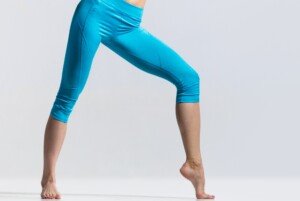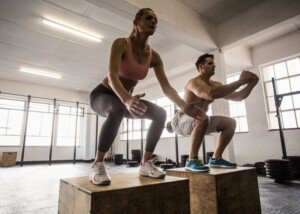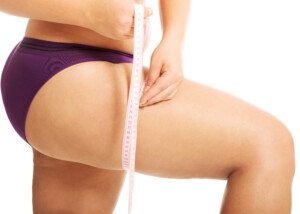
Plyometrics is a unique approach to burning fat in the thighs.
Any woman who’s been doing plyometrics for a while will not have thunder thighs.
From time to time I see women doing plyometric exercises. Some are new to it, and some—I can tell—have been doing this for a while.
The ones who are good at it or who are exercising in an advanced way – all have one thing in common:
Absence of “fat” thighs. The look of “thunder” or mushy blubbery thighs or heavy legs is completely absent.
Another commonality is that they don’t have stick legs either. Scrawny or “skinny fat” legs are not attractive, nor are they healthy.
Instead they have wonderfully sculpted, tight and firm, shapely legs — strong looking legs that will carry them gracefully through the oldest of age.

Freepik/yanalya
So what is plyometric exercise?
It’s jumping onto heights and jumping off of heights. The height is usually an exercise stool that’s designed for this purpose.
Do not use chairs, tables or other unstable platforms.
A weightlifting bench, that’s screwed into the floor, can also be used.
Another form of plyometrics is jumping in various ways on a floor, and also hopping up flights of stairs.
Your gym probably has jumping stools, with the lowest being 12 inches. You can also do jumping up and down from a single step at the bottom of a staircase if you’re not that very fit.

The other day I saw a woman alternating between light barbell squats and plyometrics with an 18 inch stool. She had killer legs.
Plyometrics is not the same as rope jumping. Rope jumping is not based on power like plyometrics is.
Why does plyometrics burn leg fat so well?
When done explosively, this form of jumping recruits fast-twitch muscle fiber—the same type of muscle fiber that’s recruited in hard sprinting.
This type of fiber, called type II, burns more energy than type I (slow-twitch).
Stool jumping to burn leg fat in the most optimal way should be done explosively and for brief periods.
Otherwise, jumping up and down on a short stool for extended periods nonstop becomes a cardio exercise that builds endurance that recruits more slow-twitch fiber, rather than a brief power-based exercise that recruits fast-twitch fiber.
But beginners will need to start training at low heights, such as the first stair of a staircase.
If you’re more fit but have never done stool jumping, then you can start with the 12 inch stool.
Floor-Based Plyometrics
• With both feet at the same time, jump side to side, tucking up the legs as much as you can.

Freepik.com, cookie_studio
This is not an endurance routine. Jump high and wide enough so that you’re very fatigued in about eight jumps.
• With both feet at the same time, leap as far out as you can in a forward direction (broad jump). Use your arms to propel yourself.
• In one spot, lower to a partial squat, then spring upward off the floor as high as you can, then come back down into the squat: squat jumps.
If you can only do four or five, you’re on the right track. Remember, this is not about endurance like jumping rope.
• As squat jumps get easier, hold light hand weights and/or squat deeper.
• Squat jumps can also be done laterally, moving side to side.
Squat jumps will fatigue your thighs quickly, but over time you will get fitter.
For stool plyometrics, leap onto the stool with both feet at the same time as well. There is no need for single-leg jumping.
When jumping off the stool, you can jump off with just enough effort to get back into the start position, or, you can leap off as far and/or as high as possible.
Plyometrics will burn thigh fat, plus help sculpt and reshape your legs.
 Lorra Garrick is a former personal trainer certified through the American Council on Exercise. At Bally Total Fitness she trained women and men of all ages for fat loss, muscle building, fitness and improved health.
Lorra Garrick is a former personal trainer certified through the American Council on Exercise. At Bally Total Fitness she trained women and men of all ages for fat loss, muscle building, fitness and improved health.









































